Family
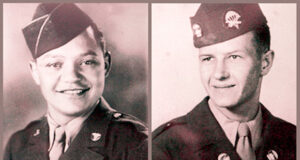 There were a number of events that took place on June 6, 1944, also known as D-Day. The areas of the Allied attack were miles away from each other. Early that morning, the Allies dropped thousands of allied paratroopers behind enemy lines in anticipation of the invasion of Normandy. It seems a strange idea to drop them behind enemy lines…like it was a big mistake. Nevertheless, one of the main objectives of the 101st Airborne was to capture the small village of Angoville-au-Plain. Then, when intense fighting broke out over the village, they dropped two American medics, Robert Wright and Kenneth Moore, in to set up a medical station in the tiny town
There were a number of events that took place on June 6, 1944, also known as D-Day. The areas of the Allied attack were miles away from each other. Early that morning, the Allies dropped thousands of allied paratroopers behind enemy lines in anticipation of the invasion of Normandy. It seems a strange idea to drop them behind enemy lines…like it was a big mistake. Nevertheless, one of the main objectives of the 101st Airborne was to capture the small village of Angoville-au-Plain. Then, when intense fighting broke out over the village, they dropped two American medics, Robert Wright and Kenneth Moore, in to set up a medical station in the tiny town 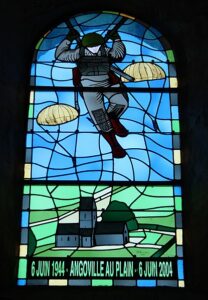 church. So, now they had not only had troops behind the lines, but they have medics…without guns behind the lines too.
church. So, now they had not only had troops behind the lines, but they have medics…without guns behind the lines too.
The plan to take over the village worked quickly and well. United States paratroopers established control of Angoville-au-Plain, but just as quickly, German units counterattacked and forced American troops back. Because of multiple injuries, Wright and Moore stayed behind. Suddenly they found themselves in danger when German soldiers entered the church. At first the German soldiers were hostile to the Americans, but then they realized that the medics were treating their wounded, as well the Allied wounded. The German troops could have attacked the men, and walked away without penalty, but instead, they left, posting a Red Cross flag at the entrance.
The fighting in the area raged on for three days, and the village changed hands several times, but the two medics never missed a beat. Over the course of the three days, they saved 80 lives, including a local teenager. The amazing part of the whole thing wasn’t just that they saved the lives, but also that the German soldiers didn’t kill them 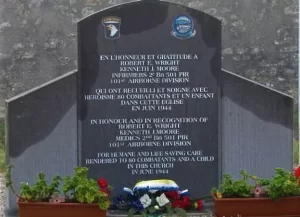 in the first place. I’m sure the medics thought that was an amazing thing. The little village of Angoville-au-Plain thought is was amazing too…not just the work of the medics, but also the work of the 101st Airborne. They thought it was amazing enough to make sure it was remembered
in the first place. I’m sure the medics thought that was an amazing thing. The little village of Angoville-au-Plain thought is was amazing too…not just the work of the medics, but also the work of the 101st Airborne. They thought it was amazing enough to make sure it was remembered
Today, all of the stained glass windows in the church (the originals were destroyed in the battle) are tributes to Wright, Moore, and the 101st Airborne. Wright visited the church in 2004, and some of his ashes were spread in Angoville-au-Plain’s cemetery as per his request, following his death on December 21, 2013. Moore passed away on December 7, 2014.
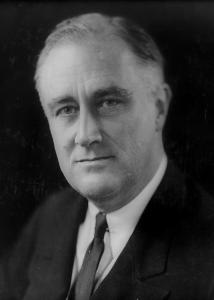 Most people believe that a there was always a two term limit on the office of the President of the United States, but that wasn’t always so. On November 5, 1940 Franklin D Roosevelt broke a long-held precedent, but not a law. The precedent was one that started with George Washington, when he became the first president elected to a third term. Roosevelt would go on to vie for, and win a fourth term, taking office again on January 20, 1945.
Most people believe that a there was always a two term limit on the office of the President of the United States, but that wasn’t always so. On November 5, 1940 Franklin D Roosevelt broke a long-held precedent, but not a law. The precedent was one that started with George Washington, when he became the first president elected to a third term. Roosevelt would go on to vie for, and win a fourth term, taking office again on January 20, 1945.
Roosevelt was the first president to win four terms, and the last president to win more than two consecutive presidential elections. His exclusive four terms were in part a consequence of timing. His election for a third term took place as the United States remained in the throws of the Great Depression and World War II had just begun. FDR (as he was known) was not the first president to try for multiple terms, but the instability of the times allowed him to make a strong case for stability…and how he, alone, could make that happen.
Says Barbara Perry, professor and director of presidential studies at the University of Virginia’s Miller Center, “You have economic-domestic issues and you have foreign policy with the outbreak of World War II in 1939. And then you have his own political viability—he had won the 1936 election with more than two-thirds of the popular vote.” It wasn’t that FDR’s policies were necessarily good for the country, and in fact, it is my opinion that most were disastrous, but since I was not born during FDR’s time in office, I suppose my only proof is history, and there are two sides to every story. All we can do is to look back at just how long it took to pull this nation out of the Great Depression, and draw our own conclusion from there. Anytime economic policies bring about big government, they hurt the American people.
The fact remains that any politician who is in office too long is a danger to this nation. I believe that we need to have term limits in every office there is. When a politician is in office too long, they begin to act like a dictator, and think that they don’t have to answer to anyone. Too much power in any one person’s hands creates greed and evil. Eventually, the United States lawmakers began to argue that term limits were necessary to keep abuse of power in check. FDR passed away on April 12, 1945, less than 3 months into his fourth term. Two years after FDR’s death, Congress passed the 22nd Amendment, limiting presidents to two terms. Then amendment was then ratified in 1951. At the time of FDR’s third presidential run, however, “There was nothing but precedent standing in his way, but, still, precedent, especially as it relates to the presidency, can be pretty powerful,” said Perry. A third consecutive run had been tried by other presidents, but they had failed. People really don’t want that.
The idea of needing term limits was not found among the framers of the Constitution, most of whom did not see the need. I’m sure they never considered man’s ability to be greedy and power-hungry, but Washington saw the importance, thus the precedent in not seeking re-election for a third time. Still, some had tried.  Ulysses S Grant lost a third campaign in 1880, when James Garfield clinched the Republican nomination. Theodore Roosevelt lost his bid at a third nonconsecutive term in 1912 to William Howard Taft (he had previously served out the remainder of President William McKinley’s term and then won reelection). And Woodrow Wilson lost the Democratic nomination in 1920. Harry Truman, who succeeded FDR after his death, was president when the 22nd Amendment passed and so was exempt from the new rule. Truman campaigned for a third term in 1952, but withdrew after losing in the New Hampshire primary. Roosevelt’s campaign for a third term took place as the United States had not yet entered World War II, and the president was still trying to hold the line in an isolationist pattern…another of his disastrous policies. And just one more reason to make term limits in all public offices mandatory.
Ulysses S Grant lost a third campaign in 1880, when James Garfield clinched the Republican nomination. Theodore Roosevelt lost his bid at a third nonconsecutive term in 1912 to William Howard Taft (he had previously served out the remainder of President William McKinley’s term and then won reelection). And Woodrow Wilson lost the Democratic nomination in 1920. Harry Truman, who succeeded FDR after his death, was president when the 22nd Amendment passed and so was exempt from the new rule. Truman campaigned for a third term in 1952, but withdrew after losing in the New Hampshire primary. Roosevelt’s campaign for a third term took place as the United States had not yet entered World War II, and the president was still trying to hold the line in an isolationist pattern…another of his disastrous policies. And just one more reason to make term limits in all public offices mandatory.
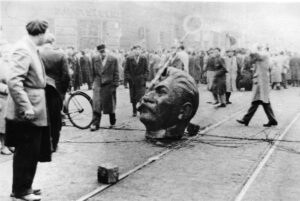 Those who support Socialism, Marxism, and Communism have simply never lived under these forms of government, or they are a part of the upper echelon of such a government. People who have been forced to live under these types of government, will ultimately try to find a way of escape or will participate in a national uprising, such as the one that happened in Hungary in 1956.
Those who support Socialism, Marxism, and Communism have simply never lived under these forms of government, or they are a part of the upper echelon of such a government. People who have been forced to live under these types of government, will ultimately try to find a way of escape or will participate in a national uprising, such as the one that happened in Hungary in 1956.
Sadly, by the time the people realize that they are in serious trouble, the government often has such a chokehold on the nation that the only way out if to have an uprising. Nevertheless, people will eventually fight for their rights, or fight to escape. While the uprising in Hungary began in October 1956, when thousands of protesters took to the streets demanding a more democratic political system and freedom from Soviet oppression, the real problem started long before that. It started when the Communist Party took over and began to systematically take away the rights of the people. There were a few people within the party who could see through the Communist Party’s ideas. When party officials appointed Imre Nagy, a former premier who had been dismissed from the party for his criticisms of Stalinist policies, as the new premier, he began to try to restore peace and asked the Soviets to withdraw their troops. The Soviets did so, but Nagy then tried to push the Hungarian revolt forward by abolishing one-party rule. He also announced that Hungary was withdrawing from the Warsaw Pact (the Soviet bloc’s equivalent of NATO).
This forced the hand of the Soviet government. On November 4, 1956, Soviet tanks rolled into Budapest to 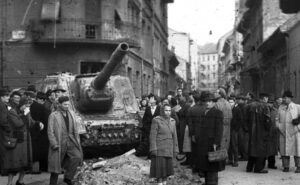 crush the national uprising, once and for all. Te fighting in the streets was vicious, but the Soviets’ greater power ensured their victory. The people had long been stripped of their weapons, and anything else that might have helped the achieve victory. At 5:20am Hungarian Prime Minister Imre Nagy announced the invasion to the nation in a grim, 35-second broadcast, declaring: “Our troops are fighting. The Government is in place.” He tried to reassure the people and keep hope alive, but within hours, Nagy sought asylum at the Yugoslav Embassy in Budapest. He was captured shortly thereafter and executed two years later. Nagy’s former colleague and imminent replacement, János Kádár, who had been flown secretly from Moscow to the city of Szolnok, 60 miles southeast of the capital, prepared to take power with Moscow’s backing. The conspiracy was complete, and the people had been betrayed…even their leader.
crush the national uprising, once and for all. Te fighting in the streets was vicious, but the Soviets’ greater power ensured their victory. The people had long been stripped of their weapons, and anything else that might have helped the achieve victory. At 5:20am Hungarian Prime Minister Imre Nagy announced the invasion to the nation in a grim, 35-second broadcast, declaring: “Our troops are fighting. The Government is in place.” He tried to reassure the people and keep hope alive, but within hours, Nagy sought asylum at the Yugoslav Embassy in Budapest. He was captured shortly thereafter and executed two years later. Nagy’s former colleague and imminent replacement, János Kádár, who had been flown secretly from Moscow to the city of Szolnok, 60 miles southeast of the capital, prepared to take power with Moscow’s backing. The conspiracy was complete, and the people had been betrayed…even their leader.
The people of the West were stunned by the Soviet action. Soviet leader Nikita Khrushchev had promised to retreat from the Stalinist policies and repression of the past, but the violent actions in Budapest told of a different plan. An out of control government will always chose its own greedy ways over the good of the people it is supposed to serve. On that day, an estimated 2,500 Hungarians died and 200,000 more fled as refugees. Sporadic armed resistance, strikes, and mass arrests continued for months thereafter, causing substantial economic disruption. The spontaneous national uprising that began 12 days before in Hungary was viciously crushed by Soviet tanks and troops on November 4, 1956.
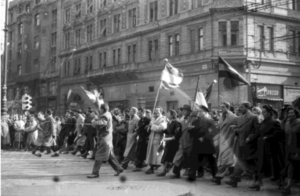
Many Hungarians were angered and frustrated by the inaction on the part of the United States. Voice of America radio broadcasts and speeches by President Dwight D Eisenhower and Secretary of State John Foster Dulles had recently suggested that the United States supported the “liberation” of “captive peoples” in communist nations, but they didn’t see that playing out in their situation. During that time, approximately 30,000 Hungarian refugees were allowed to enter the United States. Yet, as Soviet tanks bore down on the protesters, the United States did nothing beyond issuing public statements of sympathy for their plight.
 Politics is always a dirty game. That is probably why most of us don’t like career politicians. They will do or say anything to win or further their careers. “Dirty politics” has been around as long as there have been politicians…and politics isn’t even limited to just politicians. There’s office politics, military politics, law enforcement politics, and more.
Politics is always a dirty game. That is probably why most of us don’t like career politicians. They will do or say anything to win or further their careers. “Dirty politics” has been around as long as there have been politicians…and politics isn’t even limited to just politicians. There’s office politics, military politics, law enforcement politics, and more.
General George Washington wasn’t even exempt. In October 1777, while serving as the commander of the Continental Army, Washington was informed of a conspiracy to discredit him with Congress and have him replaced by General Horatio Gates. The loosely organized attempt was supposedly led by Brigadier General Thomas Conway, who was an Irish member of the French army. Conway commanded a brigade in Washington’s army, and he was unhappy with Washington’s performance in the Battle of Brandywine. Conway was also bragging about his own feats at the same operation. Conway was even so bold as to request a promotion for himself, to the rank of major general…based on the merits of his “performance” in the battle. Washington protested Conway’s promotion and was irritated by the request, believing it would have disastrous effects on the morale of more senior officers. I think the biggest problem was the arrogance of Conway. It just isn’t right to brag on yourslf so much.
Thomas Conway, would be made inspector general of the United States less than two months later on December 14, but it is my belief that it was in an effort to pigeon-hole hime, because he was an embarrassment. Conway, was born in Ireland, but raised in France. He entered the French army in 1749. Silas Deane, the American ambassador to France, recruited Conway to the Patriot cause. Conway met with Washington at Morristown in May 1777, after which, he was appointed brigadier general and assigned to Major General John Sullivan’s division. Conway served admirably under Sullivan at the battles of Brandywine, in September 1777, and Germantown, in October 1777, before becoming involved in an unconfirmed conspiracy to remove General Washington from command of the Continental Army. It ruined his military career.

Conway wasn’t alone in the cabal. The Continental Army had suffered several defeats in the fall of 1777, and some members of Congress felt it was Washington’s leadership that was to blame. Conway began writing letters to prominent leaders, including General Horatio Gates, that were critical of Washington. After Washington got wind of Conway’s letter to General Gates, he wrote his own letter to Congress in January 1778. Conway was embarrassed, and in March 1778, he offered his resignation as an apology. Nevertheless, he was surprised and humiliated when Congress accepted. After General John Cadwalader wounded him in a duel defending Washington’s honor, Conway returned to France, where he died in exile in 1800…unable to recover his dignity after the horrific Conway Cabal.
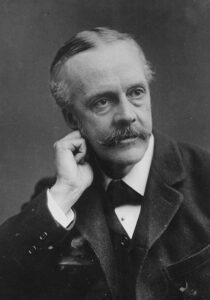 For a number of years Israel had no place to call home. That sounds like a strange thing, but for the nation of Israel, it was not a new thing. Biblical history tells us of a number of times that Israel’s God-given land was taken from them for a time, and they were taken into captivity. Even after the captivity the Jewish people were displaced from their promised land. They were also persecuted and subject to racial discrimination.
For a number of years Israel had no place to call home. That sounds like a strange thing, but for the nation of Israel, it was not a new thing. Biblical history tells us of a number of times that Israel’s God-given land was taken from them for a time, and they were taken into captivity. Even after the captivity the Jewish people were displaced from their promised land. They were also persecuted and subject to racial discrimination.
That began to change when on November 2, 1917, Foreign Secretary Arthur James Balfour wrote an important letter to Britain’s most illustrious Jewish citizen, Baron Lionel Walter Rothschild, expressing the British government’s support for a Jewish homeland in Palestine. I can only imagine how the Baron felt. This was like having someone offer you the moon. It was something the Jew never thought they would see again. Many didn’t think they would live long enough to see it. The letter would eventually become known as the Balfour Declaration, and it was the start of something good.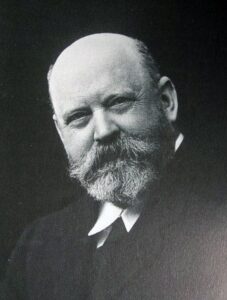
Because of concerns over the direction World War I was going, the British were very supportive of the Zionist movement. Lloyd George among others, held a genuine belief in the righteousness of Zionism, but Britain’s leaders also hoped that a statement supporting Zionism would help gain Jewish support for the Allies. On November 2, Balfour sent his letter to Baron Rothschild, who was a prominent Zionist and a friend of Chaim Weizmann, stating that: “His Majesty’s Government view with favor the establishment in Palestine of a national home for the Jewish people.”
The influence of the Balfour Declaration on the course of post-war events was immediate: According to the “mandate” system created by the Versailles Treaty of 1919, Britain was entrusted with the administration of Palestine, with the understanding that it would work on behalf of both its Jewish and Arab inhabitants. In 1948, the Balfour Declaration was scheduled to expire and Great Britain would no longer rule Palestine. The future of the Jewish people was at stake. The question over what to do with the 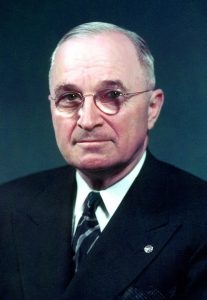 turbulent country was turned over to the United Nations. They, at the insistence of President Harry Truman, eventually decided to create the new country of Israel, specifically as a promised homeland for Jewish people. The new country was to be located across the various holy locations in which many events of the Old Testament occurred. The Jewish people were back in the promised land.
turbulent country was turned over to the United Nations. They, at the insistence of President Harry Truman, eventually decided to create the new country of Israel, specifically as a promised homeland for Jewish people. The new country was to be located across the various holy locations in which many events of the Old Testament occurred. The Jewish people were back in the promised land.
That was when United States President Harry Truman became the first world leader to officially recognize Israel as a legitimate Jewish state. On May 14, 1948, only eleven minutes after its creation the decree was delivered. His decision came after much discussion and advice from the White House staff, all of whom had differing viewpoints. Some advisors felt that creating a Jewish state was the only proper response to the Holocaust and would benefit American interests. Others took the opposite view, concerned about that the creation of a Jewish state would create more conflict in an already tumultuous region. No matter what happens, it was the right thing to do.
 I suppose that if I lived in Quebec, Canada, I might have heard the Abitibi-Témiscamingue region and maybe even the Western Quebec Seismic Zone. Since I don’t, these areas are new to me. Maybe they were new to a lot of people, but on November 1, 1935, a lot more people knew about them. On that day, a 6.1 magnitude earthquake with a maximum Mercalli intensity of VII (Very strong) occurred. The epicenter occurred on a thrust fault in the Timiskaming Graben, a little over 6 miles northeast of Témiscamingue, at about 1:03am ET.
I suppose that if I lived in Quebec, Canada, I might have heard the Abitibi-Témiscamingue region and maybe even the Western Quebec Seismic Zone. Since I don’t, these areas are new to me. Maybe they were new to a lot of people, but on November 1, 1935, a lot more people knew about them. On that day, a 6.1 magnitude earthquake with a maximum Mercalli intensity of VII (Very strong) occurred. The epicenter occurred on a thrust fault in the Timiskaming Graben, a little over 6 miles northeast of Témiscamingue, at about 1:03am ET.
While the earthquake was in Canada, it was felt over a wide area of North America, extending west to Fort William (now Thunder Bay), east to Fredericton, New Brunswick, north to James Bay and south as far as Kentucky and West Virginia. Occasional aftershocks were reported for several months. That seems extreme for a 6.1 magnitude earthquake, but I suppose it’s all in the connections. Fault lines aren’t just in a small area, they run for hundreds and even thousands of miles.
The most significant damage from the earthquake, both in the immediate area and as far south as North Bay and Mattawa, was to chimneys. In fact, 80% of the chimneys in that area were destroyed. A railroad embankment near Parent, which is 186 miles away, also collapsed. It looked like the embankment slide was already imminent, but the quake vibrated the last holds loose. There were some rockfalls and structural cracks reported as well. Thankfully, there were few major structural collapses aside from the Parent embankment. The 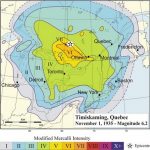
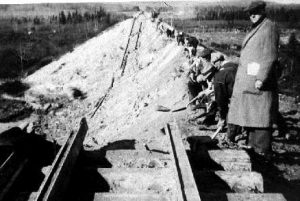 sparseness of the area’s population played a big part in the relative lack of major damage, despite the fact that it was a strong earthquake. The water of Tee Lake, close to the epicenter was discolored by the earthquake…due to a stirring up of gyttja, which is freshwater mud with abundant organic matter, rather than silt input from tributary streams. The relative lack of major damage, despite the fact that it was a strong earthquake, has been attributed primarily to the sparseness of the area’s population.
sparseness of the area’s population played a big part in the relative lack of major damage, despite the fact that it was a strong earthquake. The water of Tee Lake, close to the epicenter was discolored by the earthquake…due to a stirring up of gyttja, which is freshwater mud with abundant organic matter, rather than silt input from tributary streams. The relative lack of major damage, despite the fact that it was a strong earthquake, has been attributed primarily to the sparseness of the area’s population.
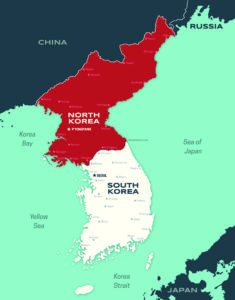 When the nations of North and South Korea were split, it was much like when Germany became East and West Germany…people were caught in the crossfire…so to speak. Despite being unified off and on for nearly 1,500 years, the Korean peninsula was divided into North and South as a result of the breakup of the Japanese empire at the end of World War II. The United States government knew that it would have to administer the Philippines, as well as Japan itself. It was a big job, so the United States was reluctant to also take trusteeship of Korea. Basically, Korea just wasn’t a very high priority for the United States. The Soviets, on the other hand, were more than willing to step in and take control of lands that the Tsar’s government had relinquished its claim to after the Russo-Japanese War (1904–05).
When the nations of North and South Korea were split, it was much like when Germany became East and West Germany…people were caught in the crossfire…so to speak. Despite being unified off and on for nearly 1,500 years, the Korean peninsula was divided into North and South as a result of the breakup of the Japanese empire at the end of World War II. The United States government knew that it would have to administer the Philippines, as well as Japan itself. It was a big job, so the United States was reluctant to also take trusteeship of Korea. Basically, Korea just wasn’t a very high priority for the United States. The Soviets, on the other hand, were more than willing to step in and take control of lands that the Tsar’s government had relinquished its claim to after the Russo-Japanese War (1904–05).
The Soviets wanted to set the country up as communist, and the United States wanted the country to be capitalist. The sad truth about the difference between communism and capitalism is that capitalism is about freedom, and communism is about slavery. The country was divided along the 38th parallel with a demilitarized zone along that line. The North Korean side of the 38th Parallel was ruled by communism, and the South was ruled by Capitalism. The economic impact was most unfortunate, in that two separate and “necessary to each other” industrial areas were now on  opposite sides. The two countries were now both poor.
opposite sides. The two countries were now both poor.
That was a sad state of affairs, but the worse state of affairs was what happened to the people. Communism being what is was, worried that if the people were allowed to cross the borders freely, they would not come back, and they were probably right. So the people who lived in North Korea and had family in South Korea were no separated from each other, and those in the south were equally separated from loved ones. It is a horrible situation, but there seemed to be no remedy for it. The separation went on for many years. Finally on October 31, 2010, the North Korean government relented to a degree. Four hundred and thirty-six South Koreans were allowed to spend three days in North Korea to meet their 97 North Korean relatives, whom they had been separated from since the 1950-1953 war. The three-day reunion was wonderful, but also bittersweet, because it was followed by a sad goodbye. The separation had been excruciating, and they had no recourse. They were at 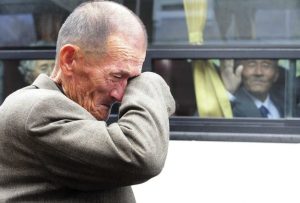 the mercy of the ruling government. Nevertheless, they were also thankful for the time to spend together, even if it meant a tearful goodbye following a luncheon meeting during inter-Korean temporary family reunions at Mount Kumgang resort.
the mercy of the ruling government. Nevertheless, they were also thankful for the time to spend together, even if it meant a tearful goodbye following a luncheon meeting during inter-Korean temporary family reunions at Mount Kumgang resort.
When you look at the realities of Socialism, Marxism, and Communism, you cannot really be surprised by the many people who are trying to escape from it’s grip. Most are willing to give their life to get out in the hope of giving their children a better life than that. Many lessons could be learned from the situation between North and South Korea, if we will only pay attention.

 My nephew, Matt Miller actually joined our family…officially, on August 14, 2021, when he married my niece, Michelle Stevens. While that was the official date, Matt has really been part of our family much longer. Matt and Michelle actually met in middle school. At that point, they became friends, but neither of them knew the future God had planned for this friendship. God planned for their friendship to grow into something so much deeper. As time went on, they knew that theirs was to be love and friendship, not just friendship. Their wedding this summer was the culmination of their years of loveship.
My nephew, Matt Miller actually joined our family…officially, on August 14, 2021, when he married my niece, Michelle Stevens. While that was the official date, Matt has really been part of our family much longer. Matt and Michelle actually met in middle school. At that point, they became friends, but neither of them knew the future God had planned for this friendship. God planned for their friendship to grow into something so much deeper. As time went on, they knew that theirs was to be love and friendship, not just friendship. Their wedding this summer was the culmination of their years of loveship.
These days, Matt and Michelle are working hard and saving their money, because it is their dream to buy a house on a piece of land. Matt wants a large shop where he can work on things and just tinker around. He loves working on things like vehicles, and if they have land, I’m sure a riding lawnmower will follow. Michelle is so proud of her husband, because he visualizes a plan, and works hard to bring it to pass. The long shifts at the coal mines are not easy, and have sometimes meant that he and Michelle don’t see each other for two or three days, because of their shift differences. I get that too, because my own husband worked in the uranium mines. It tough of them and it makes it kind of lonely for them too. Nevertheless, Matt wants the very best for his wife and future kids, and their dream is land, so that is what he is going to do. Matt has recently really gotten into snowmobiling this year too, so I’m sure his shop will include tinkering on the snowmobiles that they will most likely own soon.
Of course, no man can work all the time, and hunting allows Matt to have fun and provide meat for the family table. Matt and his dad, love to go hunting, fishing, and they share a love of guns. Matt and his dad went bow hunting for elk this year, and both got their elk. That is so uncommon. Usually one or both will have to go hunt 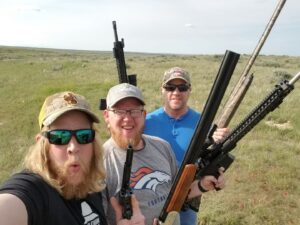
 with a rifle in order to get their elk too. Game animals are elusive, you know. It was really fun for them to succeed in getting their elk with a bow. I have no idea how to shoot an arrow with a bow…much less have enough skill to actually bag an elk with a bow. That is really something to be super proud of. It’s really been a great year for Matt. Now, he and Michelle are really looking forward to all the good things God has in store for them in the future. Today is Matt’s birthday. Happy birthday Matt!! Have a great day!! We love you!!
with a rifle in order to get their elk too. Game animals are elusive, you know. It was really fun for them to succeed in getting their elk with a bow. I have no idea how to shoot an arrow with a bow…much less have enough skill to actually bag an elk with a bow. That is really something to be super proud of. It’s really been a great year for Matt. Now, he and Michelle are really looking forward to all the good things God has in store for them in the future. Today is Matt’s birthday. Happy birthday Matt!! Have a great day!! We love you!!
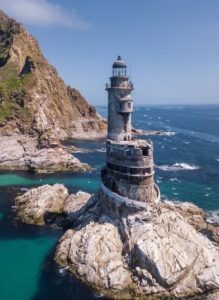 I like lighthouses. That is just a fact. I am particularly fascinated with unusual lighthouse. There are many lighthouses all over the world. They are, of course, used to direct ships away from shallow waters or dangerous rocks that lurk below the surface of the water. Today, there are more than 21,600 lighthouses worldwide, and there are a few that are still in use. In pre-GPS days, they played a vital role in the shipping industry, but these days they are usually used as tourist attractions. Many are privately owned, and are only used in an extreme emergency, when the electronic guidance systems are down. Some lighthouses are simply abandoned. I have mixed feelings about those, because when abandoned, they usually fall into disrepair, but there is something about abandoned buildings that has always intrigued me…even when they have fallen into disrepair.
I like lighthouses. That is just a fact. I am particularly fascinated with unusual lighthouse. There are many lighthouses all over the world. They are, of course, used to direct ships away from shallow waters or dangerous rocks that lurk below the surface of the water. Today, there are more than 21,600 lighthouses worldwide, and there are a few that are still in use. In pre-GPS days, they played a vital role in the shipping industry, but these days they are usually used as tourist attractions. Many are privately owned, and are only used in an extreme emergency, when the electronic guidance systems are down. Some lighthouses are simply abandoned. I have mixed feelings about those, because when abandoned, they usually fall into disrepair, but there is something about abandoned buildings that has always intrigued me…even when they have fallen into disrepair.
One such unusual, abandoned lighthouse is the Aniva Lighthouse in Sakhalin, Russia. The lighthouse is situated on a small rock called Sivuchya near the rocky Cape Aniva. It is difficult to reach, and can only be accessed by water. To make matters worse, the tides are strong there. Still, the breathtaking scenery makes the journey worth while. Construction started on Aniva Lighthouse in June 1937 and finished in October 1939, taking just over two years. Building this navigational structure was difficult: all of the construction materials had to be delivered by water. Severe weather conditions didn’t make the process any easier.
When I first saw a picture on the Aniva Lighthouse, it reminded me of the front of a ship. It almost looked like a 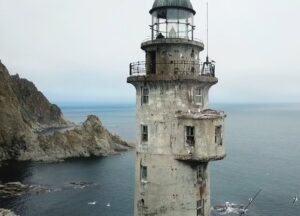 shipwreck, except for the lighthouse part, of course. Upon closer inspection, the lighthouse really doesn’t look like a ship at all, but maybe it was designed to give that illusion. The concrete tower, is painted to match the surrounding rocks, its stroboscopic lamp located 131 above the ground. The structure is round in shape and equipped with a bay window, the 9-floor tower stands on an oval base, which looks like it is coming out of the coastal rocks. Maybe that’s why it looks like a ship.
shipwreck, except for the lighthouse part, of course. Upon closer inspection, the lighthouse really doesn’t look like a ship at all, but maybe it was designed to give that illusion. The concrete tower, is painted to match the surrounding rocks, its stroboscopic lamp located 131 above the ground. The structure is round in shape and equipped with a bay window, the 9-floor tower stands on an oval base, which looks like it is coming out of the coastal rocks. Maybe that’s why it looks like a ship.
The Aniva Lighthouse was well equipped for living, no matter what the weather conditions. The basement was equipped with diesel engines and batteries. The kitchen was located on the ground floor along with the food storage The radio room, equipment room, and watch room were situated on the second floor of the lighthouse. As many as 12 people could be accommodated in the living quarters, located on the third, fourth and fifth floors, with each floor having a separate room. The interior of the quarters was modest, housing two bunk beds and small alcoves for personal belongings. Much of the light came in through small porthole windows. The storeroom was on the sixth floor. The seventh floor housed the mechanisms of a pneumatic siren, with its horn installed directly on the roof of the bay window. The eighth floor was used for fuel storage. The ninth floor housed the lens rotation mechanism of the lighthouse. The lantern rotated inside a bowl with about 660 pounds of mercury. The stroboscopic lamp was set in motion by a mechanism similar to a clockwork. Running through 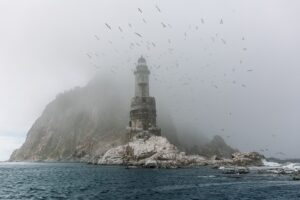 the center of a spiral staircase leading to the very top of the tower, was a pipe with a suspended weight of 595 pounds inside. It took the weight three hours to reach the bottom, rotating the lamp in the process. After that, the lighthouse keeper had to rewind the system. The lighthouse had a range of 17.5 miles. That must have been a job.
the center of a spiral staircase leading to the very top of the tower, was a pipe with a suspended weight of 595 pounds inside. It took the weight three hours to reach the bottom, rotating the lamp in the process. After that, the lighthouse keeper had to rewind the system. The lighthouse had a range of 17.5 miles. That must have been a job.
It was decided to make the Aniva Lighthouse autonomous by re-equipping it to work from a nuclear power source in the 1990s. In 2006, the radioisotope generators were removed. The lighthouse has been abandoned ever since. These days it is a haven for the birds.

 My niece, Siara Olsen had a really tough year two years ago, but God had a new plan for her life. Siara was unsure why God would send her a man who shared a birthday with her son Alec Olsen. Siara lost Alec just a little under two years ago, to RSV. Having a boyfriend who shared that birthday felt a little strange…at least until Siara got to know Chris Kirk’s heart. Today is Chris’ birthday, but he decided to give Siara and her mom, Chantel Balcerzak a spa day so that Siara wouldn’t spend the whole day thinking sad thoughts about Alec. What an incredibly kind thing to do for her…on his birthday. Siara can’t say enough about Chris’ kindness, and just how genuine guy he is.
My niece, Siara Olsen had a really tough year two years ago, but God had a new plan for her life. Siara was unsure why God would send her a man who shared a birthday with her son Alec Olsen. Siara lost Alec just a little under two years ago, to RSV. Having a boyfriend who shared that birthday felt a little strange…at least until Siara got to know Chris Kirk’s heart. Today is Chris’ birthday, but he decided to give Siara and her mom, Chantel Balcerzak a spa day so that Siara wouldn’t spend the whole day thinking sad thoughts about Alec. What an incredibly kind thing to do for her…on his birthday. Siara can’t say enough about Chris’ kindness, and just how genuine guy he is.
Chris has three siblings, one brother and two sisters. He is an amazing uncle to all of his nephews and nieces, as well  as to Siara’s nieces and nephew. He bought his one nephew brand new wrestling shoes and takes him to the gym with him. Chris is a wrestler and is competing in a wrestling tournament in Denver next weekend, so his nephew is “helping” him prepare. It’s an exciting event, and even Siara’s parents are going to watch. Chris and Siara also work out together, and I can tell that he is very athletic. They love to go hiking and have seen many cool places this summer. One of their favorites is the Bridle Trail, which happen to be one of my favorite trails too. Such a beautiful hike.
as to Siara’s nieces and nephew. He bought his one nephew brand new wrestling shoes and takes him to the gym with him. Chris is a wrestler and is competing in a wrestling tournament in Denver next weekend, so his nephew is “helping” him prepare. It’s an exciting event, and even Siara’s parents are going to watch. Chris and Siara also work out together, and I can tell that he is very athletic. They love to go hiking and have seen many cool places this summer. One of their favorites is the Bridle Trail, which happen to be one of my favorite trails too. Such a beautiful hike.
Chris and Siara have many things in common. One is football. Chris loves football, and Siara, who was a cheerleader loves it too. So, they have gone to some Wyoming games, and Chris knows that he doesn’t have to worry about his girl hating that he watches football. They are also two very fun people, who love goofing off and having a good time.
Not all of Chris’ life was just perfect. Chris spent much of his childhood in foster care, and as we all know, that 
 is not always a recipe for a child turning out well, but Chris was determined to become a good person. He wanted to be proud of himself, and so he worked to become a good man. While he did come out of foster care, he turned into a beautiful person in spite of it. As far as we, Siara’s family, are concerned, the fact that Chris is such a loving person, who treats Siara the way she deserves to be treated. And Chris is just that man. He is loving and even doting when it comes to Siara. He makes her feel spoiled and very special, and that makes us like Chris a lot. Today is Chris’ birthday. Happy birthday Chris!! Have a great day!! We love you!!
is not always a recipe for a child turning out well, but Chris was determined to become a good person. He wanted to be proud of himself, and so he worked to become a good man. While he did come out of foster care, he turned into a beautiful person in spite of it. As far as we, Siara’s family, are concerned, the fact that Chris is such a loving person, who treats Siara the way she deserves to be treated. And Chris is just that man. He is loving and even doting when it comes to Siara. He makes her feel spoiled and very special, and that makes us like Chris a lot. Today is Chris’ birthday. Happy birthday Chris!! Have a great day!! We love you!!

